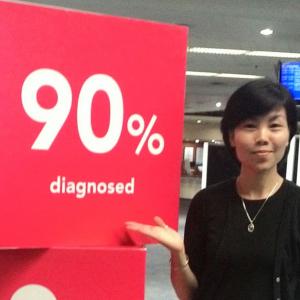The scales have tipped - UNAIDS announces more than half of all people living with HIV on life-saving treatment
20 July 2017
- HA NOI, 20 July 2017 - UNAIDS has released a new report showing that for the first time the scales have tipped: globally, more than half of all people living with HIV (53%) now have access to HIV treatment and AIDS-related deaths have almost halved in the past ten years. In 2016, 19.5 million people living with HIV had access to treatment, and AIDS-related deaths had fallen from 1.9 million in 2005 to 1 million in 2016. Provided that scale-up continues, this progress puts the world on track to reach the global Fast Track target on treatment by 2020.
In Asia and the Pacific, more than two thirds of people living with HIV were aware of their HIV status, a similar portion of those who knew their HIV status were on treatment and four out of five people on treatment achieved viral suppression in 2016. The wider availability of ARV treatment has led to a nearly one third reduction in AIDS-related deaths since 2010 in the region. Viet Nam has significantly contributed to this progress.
"Viet Nam's impressive scale-up of HIV services has resulted in clear impact on the epidemic," said Marie-Odile Emond, Country Director of UNAIDS Viet Nam. "Half of all people living with HIV in Viet Nam were on treatment in 2016 and the estimated number of AIDS-related deaths was the lowest since 2004. New HIV infections have also steadily decreased in recent years."
90-90-90: more work to do
Global and Viet Nam's progress against the 90–90–90 targets has been significant, but there is still more work to do. AIDS is not over.
New infections are declining, but not fast enough
The report shows that, globally, new HIV infections are declining, but not at a pace to meet global targets by 2020. The situation in Viet Nam is similar. New HIV infections in Viet Nam have decreased to about 11,000 in 2016 from about 28,000 during the peak years in early 2000s. However, greater scale-up of evidence-based prevention and more domestic resources for prevention including for needle and syringes and condoms are needed, in order for the country to achieve the national targets on HIV prevention.
A combination approach is needed to greatly reduce HIV risks for key populations
Outside of sub-Saharan Africa, key populations and their sexual partners accounted for 80% of new HIV infections in 2015. In Viet Nam, 2016 data indicate an HIV prevalence of 11.0% among people who inject drugs, 8.2% among men who have sex with men and 2.7% among female sex workers. The HIV epidemic among men who have sex with men in cities is getting more serious. Women whose husbands or male intimate partners are men living with HIV or men with behaviours putting them at risk are increasingly accounting for a greater portion of new HIV infections. Integrated and community-based HIV services as well as successful innovative and user friendly approaches are essential for greater HIV service access and uptake by key populations and need to be scaled up.
Closing the gaps across the HIV testing and treatment cascade
Though the country has a Treat All policy and has made great efforts in decentralising treatment and improving linkage from testing to treatment, among the 70% of people living with HIV in Viet Nam who know their HIV status, one third is not on HIV treatment yet. Stigma and discrimination is also still a major barrier in accessing HIV services and hampering the national response to HIV.
Sharing greater responsibility for HIV investments and maximizing efficiencies
Globally, resources for the AIDS response remain flat. In Asia and the Pacific, domestic resources for HIV have doubled over the past decade but international contributions fell about 25% in the last five years, meaning additional resources are still needed in the region. In Viet Nam, the latest available data shows domestic resources accounted for nearly one third of the national AIDS spending in 2015, and it is increasing. Generating greater efficiencies and optimizing the use of available resources is crucial for Viet Nam to maximize the return on investment and accelerate impact against the epidemic.
"Viet Nam continues to shows great determination to sustain the response to HIV by increasing domestic financing for HIV through social health insurance and greater share of the financing responsibility by local governments," said Ms. Emond, "Investing sufficiently and wisely, now rather than later, and optimizing all available financial and human resources at all levels will help Viet Nam avoid a more complex and more costly HIV response in the future, and end the AIDS epidemic by 2030."



